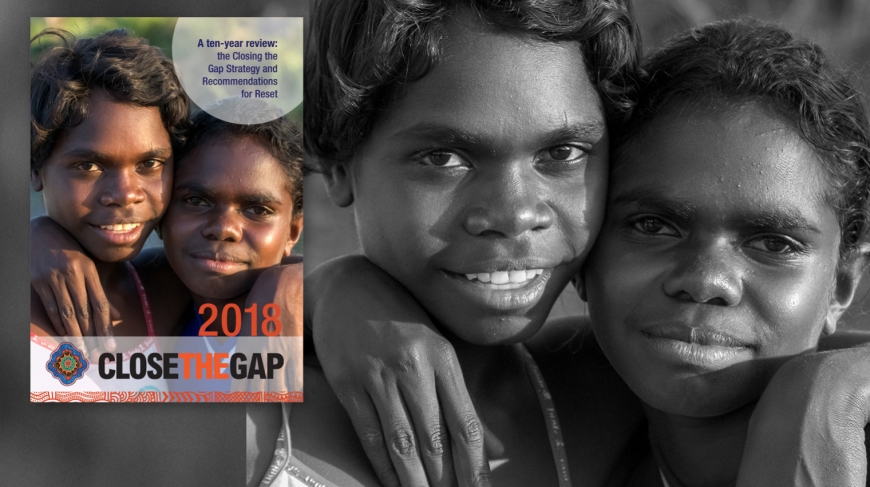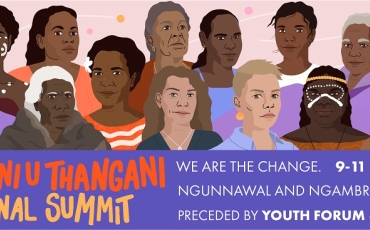Close The Gap - 10 Year Review (2018)

Executive Summary
This review assesses the most significant national effort to date to improve Aboriginal and Torres Strait Islander health: the 2008 Council of Australian Governments’ (COAG) Closing the Gap Strategy with its target to achieve life expectancy (health) equality by 2030. Ten-years after its commencement, it is time to critically reflect on why Australian governments have not yet succeeded in closing the health gap to date, and why they will not succeed by 2030 if the current course continues. In fact, a December 2017 Australian Institute of Health and Welfare report found the mortality and life expectancy gaps are actually widening due to accelerating non-Indigenous population gains in these areas.
The COAG Closing the Gap Strategy was developed by Australian governments following their signing of the Close the Gap Statement of Intent from March 2008 onwards. The Close the Gap Statement of Intent is, first, a compact between Australian governments and Aboriginal and Torres Strait Islander peoples. Second, it embodies a human right to health-based blueprint for achieving health equality referred to hereon as the ‘close the gap approach’.
The close the gap approach and the Close the Gap Statement of Intent is founded on an understanding that population health outcomes are fundamentally the result of underlying structural factors, such as social determinants, institutional racism, the quality of housing, and access to appropriate primary health care. If governments want to improve and sustain the health of any population over time, these elements must be addressed. What this means is that sustainable improvements to the health of a population will ultimately depend on the quantum, quality, coherence and coordination of the health system and other governments’ inputs in these areas. The close the gap approach then is founded on an evidence-based understanding that health outcomes will sustainably improve on a population basis if there are sufficient, purposeful and effective inputs to address these underlying factors.
This does not mean that funding should be pulled from Closing the Gap Strategy elements such as addressing preventable, chronic and communicable diseases and child and maternal health. Indeed, there is an obligation to address these, including risk behaviours (such as smoking) within a rights-based approach. However, policy makers should not take their eyes off the ‘main game’: sustainable long-term improvement to the health of Aboriginal and Torres Strait Islander peoples by addressing the underlying structural factors – treating the causes rather than focusing on symptoms.
Indeed, without this additional focus, responses to chronic and communicable diseases are likely to be unsustainable, a metaphorical ‘band aid’, rather than resulting in permanent health gains and, ultimately, Aboriginal and Torres Strait Islander life expectancy equality in 2030 and beyond.
The close the gap approach and the Close the Gap Statement of Intent also incorporate the Federal Government-supported United Nations Declaration on the Rights of Indigenous Peoples (the Declaration) articulation of the right to health as it applies to Indigenous peoples. In short, this requires governments to respect Indigenous peoples’ right to self-determination in efforts to improve their health. At the national level, this means Aboriginal and Torres Strait Islander government partnerships in health planning. At the community level, it means community governance and control of health services. In other words, to ‘get the inputs right’, investment must be guided into the kinds of services, health infrastructure and other responses as determined by Aboriginal and Torres Strait Islander health leaders and communities.
This review’s major findings are:
1. the Close the Gap Statement of Intent (and close the gap approach) has to date only been partially and incoherently implemented via the Closing the Gap Strategy:
–– An effective health equality plan was not in place until the release of the National Aboriginal and Torres Strait Islander Health Plan Implementation Plan in 2015 – which has never been funded. The complementary National Strategic Framework for Aboriginal and Torres Strait Islander Peoples’ Mental Health and Social and Emotional Wellbeing 2017-2023 needs an implementation plan and funding as appropriate. There is still yet to be a national plan to address housing and health infrastructure, and social determinants were not connected to health planning until recently and still lack sufficient resources.
–– The Closing the Gap Strategy focus on child and maternal health and addressing chronic disease and risk factors – such as smoking through the Tackling Indigenous Smoking Program – are welcomed and should be sustained. However, there was no complementary systematic focus on building primary health service capacity according to need, particularly through the Aboriginal Community Controlled Health Services and truly shifting Aboriginal and Torres Strait Islander health to a preventive footing rather than responding ‘after the event’ to health crisis.
2. The Closing the Gap Strategy – a 25-year program – was effectively abandoned after five-years and so cannot be said to have been anything but partially implemented in itself. This is because the ‘architecture’ to support the Closing the Gap Strategy (national approach, national leadership, funding agreements) had unravelled by 2014-2015.
3. A refreshed Closing the Gap Strategy requires a reset which re-builds the requisite ‘architecture’ (national approach, national leadership, outcome-orientated funding agreements). National priorities like addressing Aboriginal and Torres Strait Islander health inequality have not gone away, are getting worse, and more than ever require a national response. Without a recommitment to such ‘architecture’, the nation is now in a situation where the closing the gap targets will measure nothing but the collective failure of Australian governments to work together and to stay the course.
4. A refreshed Closing the Gap Strategy must be founded on implementing the existing Close the Gap Statement of Intent commitments. In the past ten years, Australian governments have behaved as if the Close the Gap Statement of Intent was of little relevance to the Closing the Gap Strategy when in fact it should have fundamentally informed it. It is time to align the two. A refreshed Closing the Gap Strategy must focus on delivering equality of opportunity in relation to health goods and services, especially primary health care, according to need and in relation to health infrastructure (an adequate and capable health workforce, housing, food, water). This should be in addition to the focus on maternal and infant health, chronic disease and other health needs. The social determinants of health inequality (income, education, racism) also must be addressed at a fundamental level.
5. There is a ‘funding myth’ about Aboriginal and Torres Strait Islander health – indeed in many Indigenous Affairs areas – that must be confronted as it impedes progress. That is the idea of dedicated health expenditure being a waste of taxpayer funds. Yet, if Australian governments are serious about achieving Aboriginal and Torres Strait Islander health equality within a generation, a refreshed Closing the Gap Strategy must include commitments to realistic and equitable levels of investment (indexed according to need). Higher spending on Aboriginal and Torres Strait Islander health should hardly be a surprise. Spending on the elderly, for example, is higher than on the young because everyone understands the elderly have greater health needs. Likewise, the Aboriginal and Torres Strait Islander population have, on average, 2.3 times the disease burden of non-Indigenous people. Yet on a per person basis, Australian government health expenditure was $1.38 per Aboriginal and Torres Strait Islander person for every $1.00 spent per non-Indigenous person in 2013-14.3 So, for the duration of the Closing the Gap Strategy Australian government expenditure was not commensurate with these substantially greater and more complex health needs. This remains the case. Because non-Indigenous Australians rely significantly on private health insurance and private health providers to meet much of their health needs, in addition to government support, the overall situation for Aboriginal and Torres Strait Islander health can be characterised as ‘systemic’ or ‘market failure’. Private sources will not make up the shortfall. Australian government ‘market intervention’ – increased expenditure directed as indicated in the recommendations below – is required to address this. The Close the Gap Campaign believes no Australian government can preside over widening mortality and life expectancy gaps and, yet, maintain targets to close these gaps without additional funding. Indeed, the Campaign believes the position of Australian governments is absolutely untenable in that regard.



